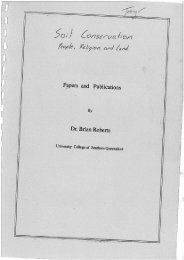Parthenium weed (Parthenium hysterophorus) - South West NRM
Parthenium weed (Parthenium hysterophorus) - South West NRM
Parthenium weed (Parthenium hysterophorus) - South West NRM
Create successful ePaper yourself
Turn your PDF publications into a flip-book with our unique Google optimized e-Paper software.
2<br />
Growth calendar<br />
Jan<br />
Feb<br />
Mar<br />
Apr<br />
May<br />
Jun<br />
Jul<br />
Aug<br />
Sep<br />
Oct<br />
Nov<br />
Dec<br />
Flowering<br />
Seed formation<br />
Seed drop<br />
Plant death<br />
Germination<br />
General growth pattern<br />
Growth pattern under suitable conditions<br />
4 mm<br />
<strong>Parthenium</strong> <strong>weed</strong> can flower year round.<br />
Photo: Colin G. Wilson<br />
<strong>Parthenium</strong> <strong>weed</strong> – <strong>Parthenium</strong> <strong>hysterophorus</strong><br />
<strong>Parthenium</strong> <strong>weed</strong> normally germinates in spring and early summer, produces flowers<br />
and seed throughout its short life and dies in late autumn. However, with the right<br />
conditions (rain, available moisture, mild soil and air temperatures), parthenium <strong>weed</strong><br />
can grow and produce flowers at any time of the year. In a good season, four or<br />
five generations may emerge. In summer, if plants are stressed (eg due to lack of<br />
water), parthenium <strong>weed</strong> can complete its life cycle in four weeks. Buried seeds<br />
have been found to last much longer than seed on the soil surface, and a significant<br />
proportion can still germinate after eight to ten years.<br />
How it spreads<br />
<strong>Parthenium</strong> <strong>weed</strong> can produce large<br />
quantities of seed, up to 100,000 per<br />
plant. More than 340 million parthenium<br />
<strong>weed</strong> seeds per hectare can be present<br />
in the surface soil, compared to 120,000<br />
native grass seeds.<br />
The seed is easily spread by vehicles,<br />
machinery and animals, and in pasture<br />
seed, stock feed and water. Most long<br />
distance spread is in produce, vehicles<br />
and farm machinery. It can also be<br />
spread by flooding and by animals.<br />
<strong>Parthenium</strong> <strong>weed</strong> was first discovered<br />
in Queensland in 1955. In a short time<br />
it spread from isolated outbreaks to<br />
establish core infestations across the<br />
Central Highlands of Queensland and<br />
into New <strong>South</strong> Wales and the<br />
Northern Territory.<br />
Where it grows<br />
In Queensland it grows best on alkaline,<br />
clay-loam to heavy black clay soils but<br />
tolerates a wide variety of soil types. It<br />
aggressively colonises areas with poor<br />
groundcover and exposed soil such as<br />
wastelands, roadsides and overgrazed<br />
pastures. It does not usually become<br />
established in undisturbed vegetation<br />
or vigorous pastures. Drought, and<br />
subsequent reduced pasture cover, create<br />
the ideal opportunity for parthenium<br />
<strong>weed</strong> to establish. Flooded country is<br />
also very prone to parthenium <strong>weed</strong><br />
distribution and flooded pastures may<br />
need to be spelled from grazing to gain<br />
their competitive edge.<br />
Potential distribution<br />
<strong>Parthenium</strong> <strong>weed</strong> is best suited to areas<br />
with an annual summer rainfall greater<br />
than 500 mm. Based on climate suitability,<br />
it could potentially grow in all mainland<br />
states and territories.<br />
What to do about it<br />
Preventing spread into new<br />
areas<br />
Preventing the spread of parthenium<br />
<strong>weed</strong> is the most cost-effective<br />
management strategy.<br />
There is a high risk of spreading<br />
parthenium <strong>weed</strong> by the movement of<br />
vehicles, machinery, livestock, grain and<br />
other produce. Queensland has a number<br />
of washdown facilities and contractors<br />
are required to clean harvesters and other<br />
equipment before leaving the state. All<br />
harvesters are inspected as they cross the<br />
Queensland – New <strong>South</strong> Wales border.<br />
<strong>Parthenium</strong> <strong>weed</strong> infests more than eight<br />
million hectares of central Queensland<br />
with serious outbreaks in the south and<br />
north of the state. Outbreaks, many of<br />
which have been controlled, have been<br />
found throughout New <strong>South</strong> Wales as<br />
far south as the Victorian border.<br />
<strong>Parthenium</strong> <strong>weed</strong> can germinate, grow, mature and set seed in four weeks.<br />
Photo: Sheldon Navie<br />
150 mm<br />
W e e d M a n a g e m e n t<br />
G u i d e • P a r t h e n i u m w e e d – P a r t h e n i u m h y s t e r o p h o r u s

















